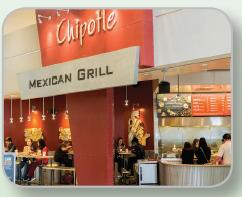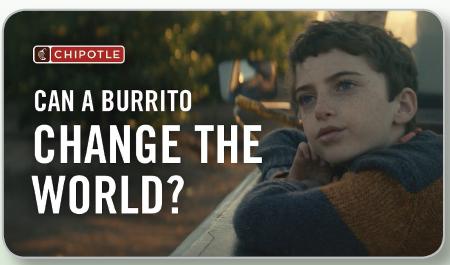Integrated marketing communications is something that we live day-in and day-out at Chipotle, exclaims Stephanie Perdue, vice
Question:
“Integrated marketing communications is something that we live day-in and day-out at Chipotle,” exclaims Stephanie Perdue, vice president of brand marketing at Chipotle. “It is so important to our marketing strategy. . . . We think about every touch point, whether it is a multimilliondollar Super Bowl commercial or a free post on Instagram, as an opportunity to connect to the customer in a relevant way to talk about our brand.” This approach to integrating all of Chipotle’s marketing communication activities is one of the key factors contributing to the success of Chipotle Mexican Grill.
THE COMPANY Chipotle founder Steve Ells has an inspiring story. After graduating from the Culinary Institute of America, Ells served as sous chef under celebrity chef Jeremiah Tower at Stars restaurant in San Francisco. He observed the popularity of burritos at local taquerias and moved to Denver to open the first Chipotle Mexican Grill near the University of Denver campus. With $85,000 borrowed from family, Ells developed a business model based on the concept of “food with integrity.” “We decided long ago that we didn’t want our success to be tied to the exploitation of animals, farmers, or the environment, but the engagement of our customers,” explains Ells.
The restaurants use only fresh ingredients and they do not have freezers, microwave ovens, or can openers. In fact, the Chipotle website proclaims, “Chipotle was born of the radical belief that there is a connection between how food is raised and prepared, and how it tastes. Real is better. Better for You, Better for People, Better for Our Planet. It may be the hard way to do things but it’s the right way.” Chipotle’s menu is relatively simple, offering burritos, burrito bowls, quesadillas, tacos, salads, sides, and a kid’s meal. In-store customers create their food by moving down a line of ingredients to choose what they want.
“We really take a lot of pride in that there are 53 ingredients that make up our menu. They are all things that you would find in your own kitchen,”
explains Perdue. Online customers make their choices digitally.
Ells’s success with his first restaurant led him to open additional locations in Colorado. After five years McDonald’s invested in Chipotle and helped the company open 500 additional locations. Eventually, McDonald’s sold its share of Chipotle to focus on its original operations. Today there are more than 2,800 Chipotle locations worldwide with more than 100,000 employees and $6 billion in revenue.
In addition to its marketplace success, Chipotle has had a significant impact on the industry as many of its practices have been adopted by other restaurant chains and those practices encourage a general approach now called “sustainable agriculture.”

THE FAST CASUAL RESTAURANT MARKET Chipotle’s restaurant category includes Qdoba Mexican Eats, Moe’s Southwest Grill, Baja Fresh Mexican Grill, and Rubio’s Coastal Grill. In addition, however, Chipotle competes indirectly with other restaurants that are quick, inexpensive, and healthier than traditional fast food, a category of restaurants called “fast casual” that Chipotle helped create. The fast casual category includes restaurants such as Portillo’s, Au Bon Pain, Noodles & Company, Panera Bread, Panda Express, and Culver’s. The global fast casual market is more than $125 billion and growing at a rate of 8 percent. Changing tastes are driving the growth as consumers search for healthy dining choices. The shift in preferences has huge implications as fast casual currently represents just 8 percent of the restaurant industry, while full service and fast food are 48 percent and 44 percent, respectively.
According to Perdue there is “lots of opportunity ahead. . . . I definitely see the shifts continuing to favor fast casual because today customers need a lot of easy and convenient choices.”
INTEGRATED MARKETING COMMUNICATIONS AT CHIPOTLE As a startup Chipotle’s communication program consisted of word-of-mouth advertising and also some billboards and radio ads. The company, however, quickly added a variety of creative promotional activities. For example, Chipotle offered free burritos to people who came to a store dressed as a burrito on Halloween. The promotion became known as the Boorito Halloween Celebration, which also offered discounts for customers dressed as processed food products. Similarly, Chipotle ran a contest on Twitter and Facebook offering a dinner for two for the 20 best burrito-themed haikus submitted by customers. Another promotion supported healthier school lunches by making donations based on how many spam e-mails customers forwarded to Chipotle. More recently, Chipotle even created a promotion called “freeting” during the NBA Finals. “Anytime the announcer said ‘free’ we gave free burritos on Twitter!” explains Perdue.
You might remember some of Chipotle’s past advertising campaigns such as “The Scarecrow” and “Back To The Start.” One of the most recent campaigns, “Can a Burrito Change the World?,” ran during the Super Bowl and highlighted Chipotle’s Food With Integrity standards.
For example, the standards encourage ingredients that are responsibly sourced, humanely raised, and do not contain artificial colors, flavors, or preservatives.
As Perdue explains, the ad “featured a young boy arguing with his sister, while both were eating a burrito. The boy imagined a world where we cared about the farmers that grew his food, and we cared about the water that we’re using to grow the crops.” Another campaign featured Bill Nye the Science Guy introducing the “Real Foodprint,” a sustainability impact tracker. The online tool allows customers to view the impact of purchase decisions on carbon in the atmosphere, gallons of water saved, soil health, organic land supported, and the use of antibiotics. The current “For Real” campaign emphasizes Chipotle’s commitment to offering food made with real ingredients. As the number of campaigns and promotions increases, integrated marketing becomes increasingly important.
The recent pandemic led Chipotle to integrate a variety of new digital and mobile initiatives into its marketing program. These efforts made delivery, mobile pickup, and curbside pickup a priority and led to the company receiving the Mobile Marketer of the Year award from Marketing Dive, and its chief marketing officer being named Adweek’s Top CMO. As the potential for traditional in-store experiences increases again,

Chipotle plans to offer an omnichannel, or digitalphysical, experience. Elements of this experience include a chatbot to help customers, a new experience rating system, and mobile order-ahead drive-thru “Chipotlanes.” According to Perdue, “you order Chipotle on your phone, drive through, get your food and leave, creating a frictionless experience........”
Questions
1. What factors contributed to Chipotle Mexican Grill’s early success? How does the company continue to create customer value?
2. Which of the promotional elements described in Figure 18–2 are used by Chipotle as part of its marketing communication program?
Fig 18-2

3. How does Chipotle integrate its message across the many promotional elements it uses?
4. Describe possible future marketing actions Chipotle is likely to undertake, and actions it should consider.
Step by Step Answer:






